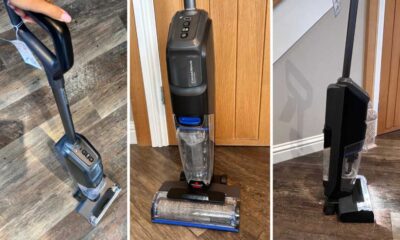Gadgets
Best of CES 2025 Awards: Tech Advisor’s Top Picks

CES (the Consumer Electronics Show) is always a bang to start the year. The humongous annual tech show in Las Vegas sees big and small brands from around the world show their latest and greatest wares.
From the genuinely useful to the absolutely bizarre, it’s got everything and CES 2025 is no different. As usual, we’ve been clocking up ridiculous step counts around the show floors in order to find the best new gadgets you’ll want to buy this year.
Weird, wonderful, wacky… these are the products we’ve awarded Best in Show at CES 2025 – from sock-grabbing robot vacuum cleaners to solid gold smart rings.
Roborock Saros Z70
Emma Rowley / Foundry
The Saros Z70 was one of the triumphs of CES, with a grabby display that caught everyone’s attention. Grabby because this robot vacuum has a robotic arm that extends from a compartment on the top to pick up small items left on your floor. That’s right: this is the first robot vacuum that can tidy as well as clean.
The demo model was able to locate and lift up a thick glove, and drop it into a nearby basket. The claw, which Roborock calls the OmniGrip 1.0, can carry objects with a weight of up to 300g, and it can extend and move in five different directions from its rotating base.
Incredibly, the robotic arm does not add bulk to the machine: once folded into its compartment, the robot’s body is a compact 7.98cm tall.
Ultrahuman Rare

Emma Rowley / Foundry
Wearable tech isn’t always hugely fashion-forward, but Ultrahuman is aiming to change that with a luxury smart ring that’s real gold – or platinum, if that’s more your bag – rather than the titanium or tungsten carbide coating that tends to be standard.
The Ultrahuman Rare ring comes in three shades: Dune (gold), Desert Rose (rose gold) and Desert Snow (platinum). The gold used in production was sourced from the London Bullion Market and is hallmarked, as you’d expect with any piece of high-quality jewellery. The rings have a subtly textured design that sets them apart from rivals at a glance.
What we like is the idea that smart wearables are moving out of their own, vaguely sporty, function-first, style-second niche. We can’t attest to the weight of the Rare or how comfortable it is, however, as the models, which are priced from £1,500-£1,800 (around $2,000 in the US) were kept locked securely in their case during the unveiling at CES.
Halliday smart glasses
These lightweight, stylish spectacles are in fact smart glasses. Embedded in the frame is a tiny round module that projects a green text display that you can see in the top right of your field of vision, giving you access to notes, phone notifications and real-time language translation. In the future, you’ll also be able to access an AI virtual assistant through them.
The glasses are paired with a smart ring which doubles as a controller, allowing you to scroll and make adjustments without touching the glasses themselves.
What’s clever about the tech set-up is that it obviates the need for AR lenses and means you can have them fitted with your regular prescription. These are, without a doubt, the most wearable smart glasses available now and a proper rival for the Ray-Ban Meta.
TCL Nxtpaper 11 Plus

Anyron Copeman / Foundry
TCL has revealed Nxtpaper 4.0, the latest version of its colour-shifting screen tech. And it’s debuting on the Nxtpaper 11 Plus, the company’s new 11-inch tablet.
Like the previous version found on the Nxtpaper 14, the technology lets you switch between full colour, colour E-Ink and monochrome E-Ink modes at the press of a physical button. However, the Nxtpaper 4.0 offers improvements to image clarity and colour accuracy, with full coverage of the sRGB gamut. There are also new AI-powered Smart Eye Comfort (for reduced eye strain) and Personalized Eye Comfort (tailored to your usage) modes.
Elsewhere, the Nxtpaper 14 Plus gets the first suite of AI features of any tablet. These include writing assist tools and smart voice recording functionality (including transcription, summary and mind map functionality), plus real-time translation and subtitling features. Circle to Search is also supported.
The display itself is a 2.2K panel with a 120Hz refresh rate and support for the T-Pen stylus, which offers a realistic pen-on-paper like experience. The experience is powered by MediaTek’s Helio G99 chipset.
Dreame X50 Ultra

Emma Rowley / Foundry
The headline feature of Dreame’s new X50 Ultra is its ‘ProLeap’ technology: it’s the step-climbing robot. Thanks to a set of robotic legs that extend to angle the robot’s body upwards, it can climb a step of up to 4.2cm, or combined steps of 6cm.
When combined with the X50 Ultra’s VersaLift tech, which allows the navigation tower to retract into the body of the vacuum to clean under lower pieces of furniture, the X50 Ultra is a robot that can access parts of the home that rivals can’t.
We were lucky enough to get an early product sample for testing ahead of CES, and can say that it’s an impressive machine.
Circular Ring 2

-

 Destination8 months ago
Destination8 months agoSingapore Airlines CEO set to join board of Air India, BA News, BA
-

 Breaking News10 months ago
Breaking News10 months agoCroatia to reintroduce compulsory military draft as regional tensions soar
-

 Tech News12 months ago
Tech News12 months agoBangladeshi police agents accused of selling citizens’ personal information on Telegram
-

 Gadgets3 months ago
Gadgets3 months agoSupernatural Season 16 Revival News, Cast, Plot and Release Date
-

 Productivity11 months ago
Productivity11 months agoHow Your Contact Center Can Become A Customer Engagement Center
-

 Gadgets3 weeks ago
Gadgets3 weeks agoFallout Season 2 Potential Release Date, Cast, Plot and News
-

 Breaking News10 months ago
Breaking News10 months agoBangladesh crisis: Refaat Ahmed sworn in as Bangladesh’s new chief justice
-

 Toys12 months ago
Toys12 months ago15 of the Best Trike & Tricycles Mums Recommend

























